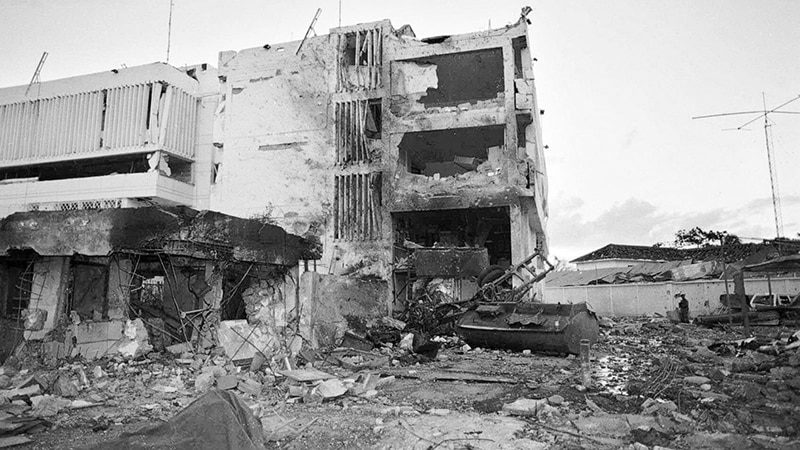1998 United States Embassy Bombings – Motivation, Attacks, Aftermath and More
The 1998 United States Embassy bombings took place exactly on the 7 of August year 1998. Over two hundred people were murdered in two cities in East Africa in virtually simultaneous truck bomb blasts, one at the US Embassy in Tanzania’s Dar es Salaam and the other at the US Embassy in Kenya’s Nairobi.
The bombings, which were associated with the (EIJ) Egyptian Islamic Jihad’s local members, brought Ayman al-Zawahiri, Osama bin Laden, and al-Qaeda, their terrorist group, to the American public’s attention, and led to Osama bin Laden being added to the FBI‘s ten most-wanted criminals list. The 1998 United States Embassy Bombings attack was also linked to Azerbaijan, according to the FBI, since bin Laden made 60 calls by satellite phone to accomplices in Baku, Azerbaijan’s capital. The masterminds responsible have been identified as Abdullah Ahmed and Fazul Abdullah Mohammed.
Source of Motivation and Planning of the 1998 United States Embassy Bombings
The 1998 United States Embassy bombings and attacks were widely assumed to be in retaliation for the US involvement in the alleged torture and expedition of four EIJ members who had been captured in Albania two months earlier for a supposed series of killings in Egypt. Between June to July, Ibrahim al-Sayyid al-Naggar Ahmad, Ahmad Isma’il ‘Uthman Saleh, Tita Mohamed Hassan, and Shawqi Mustafa Salama Atiya, were all extradited from Albania back to Egypt with the help of the US army; the 4 men were accused of assassinating Rifaat el-Mahgoub, and a further plot to hit the market of Khan el-Khalili in Cairo. A month later, the United States was warned in a communiqué that a “reaction” was being planned to “repay” their intervention. The report by the 9/11 Commission, on the other hand, indicates that planning began soon after bin Laden announced his fatwa in February 1998.

The operation in Nairobi was named in honor of Mecca’s Holy Kaaba, according to writer Lawrence Wright, while the Dar es Salaam attack was dubbed the al-Aqsa Operation in Jerusalem. However, “neither of them seemed to have any ties to the African American embassies.” At first, Bin Laden said that the locations were targeted due to Somalia’s ‘invasion,” and then went on to outline an American plot to split Sudan, which he claimed was devised in the US embassy in Nairobi. He also claimed that the Rwandan genocide was orchestrated in the two embassies. ” Bin Laden’s true purpose, according to Wright, was to “lure the US to Afghanistan, which was famous for being ‘Empires’ Graveyard.”
One of the 1998 United States Embassy Bombings attackers bought a property in Nairobi in May 1998 with the intention of building a bomb in the garage. In Nairobi, Sheikh Salim Ahmed Sweden bought a Toyota Dyna truck, beige in color, and in Dar es Salaam, he bought a refrigeration truck, a 1987 Nissan Atlas. To fit the bomb, 6 metal bars were utilized to build a “cage” on the rear of the Atlas.
KK Mohamed leased House 213 in Dar es Salaam’s Illala district in June 1998, around 4 miles (6 kilometers) from the United States embassy. The bomb components were transported to House 213 using a Suzuki Samurai white in color, while disguised in rice bags.
Mohammed Odeh oversaw the building of two 2,000-pound (900 kilograms) explosive devices in both Dar es Salaam and Nairobi. 400 to 500 TNT cylinders as big as drink cans, aluminum powder, ammonium nitrate, and detonating string were used to make the Nairobi bomb. They were loaded into twenty specially built wooden crates, which were then sealed and loaded into the trucks’ beds. Musa Muhsin Atwah Matwalli connected the bomb to a pair of batteries in the truck cab’s rear, which he then connected to a detonating switch beneath the dashboard. The TNT in the Dar es Salaam explosive was linked to fifteen gas canisters and oxygen tanks and was encircled by four sacks of ammonium nitrate fertilizer as well as several sandbags to tamp down and guide the 1998 United States Embassy bombings.
The 1998 United States Embassy bombings were timed to occur on August 7, to coincide with the 8th anniversary of the entry of US forces to Saudi Arabia in the early phase of the Persian Gulf War, a decision presumably made by Osama bin Laden.
1998 United States Embassy Bombings Causalities and Attacks
On 7 August, suicide bombers parked the explosives-laden vehicles outside the US embassies in Nairobi and Dar es Salaam between 10:30 to 10:40 a.m. local time (3:30 to 3:40 a.m. EDT) and detonated almost simultaneously. The Nairobi bomb killed 213 people, while the Dar es Salaam blast killed 11. Approximately 4,000 people were injured in Nairobi, with 85 more wounded in Dar es Salaam. After the 1998 United States Embassy bombings, seismological scans revealed energy ranging from 2.7 – 15.4 metric tons (3-17 short tons) of highly explosive material. Despite the fact that the assaults were targeted at American institutions, the great majority of the victims were citizens of the 2 African countries. 12 Americans died, including 2 CIA personnel at the embassy in Nairobi, Tom Shah (alias Uttamilal Shah Thomas) and Molly Hardy Huckaby, and one United States Marine, Sergeant Jesse (alias “Nathan”) Aliganga, a Security Guard at the US Nairobi embassy. Among the twelve Americans killed in the incident was Kenneth Ray Hobson II, a US army Sergent.
While Azzam and Mohamed Rashed Daoud Al-Owhali drove swiftly toward the US Nairobi embassy in their Toyota Dyna, Benson Bwaku Okuku, a native security guard, was instructed to immediately open the gates and was shot at upon his refusal. Before alighting from the truck and fleeing, Al-Owhali hurled a stun grenade toward embassy security. Later, Osama explained that Al-Owhali had exited with an intention of shooting the guards so as to create a route for the Toyota Dyna, but had mistakenly left his weapon in the vehicle and subsequently fled. The vehicle exploded while Bwaku radioed for backup from Marine Post One.
The explosion destroyed the embassy and caused the nearby Ufundi Building to collapse, killing the majority of the victims, who were mostly students and personnel of the secretarial college that was situated there. The blast’s heat was directed between the buildings, igniting a crowded commuter bus on Haile Selassie Avenue. Windows were destroyed within a 12-mile (800-meter) radius. People in surrounding buildings who heard the first-hand grenade explosion and the gunfire rushed to the windows of their offices to look out when the major blast smashed the panes, resulting in a substantial number of people with eye injuries.

Meanwhile, Khalif Hamden Allah Awad, previously a camp trainer who only arrived in the nation a couple of days before, was driving the Atlas truck that bombed the US Embassy in Da es Salaam’s 36 Laibon Road. He was nicknamed “Ahmed the German” owing to his blond hair. The death toll there was lower than Nairobi’s because the United States embassy was situated out of the city center in the upscale Oysterbay district, and the suicide bombers were deterred from approaching the facility by a water truck.
Following the strikes, the “Liberation Army for Holy Sites” claimed responsibility for the bombs used in the 1998 United States Embassy bombings. Investigators in the United States think the word was a ruse used by EIJ, the group that carried out the attacks.
International Response and Aftermath of the 1998 United States Embassy Bombings
President Bill Clinton authorized Operation Infinite Reach, which saw several missile attacks on targets in Afghanistan and Sudan on 20 August 1998, in retaliation to the 1998 United States Embassy bombings, outlining the upcoming strike in an address on American television.
Resolution 1189 of the UN Security Council condemned the bombings of the embassies.
The two embassies were severely damaged, with the Nairobi US embassy requiring reconstruction. For security reasons, it is currently positioned across the UN Office in Nairobi.
On the 3rd anniversary of the United State Embassy bombings, a memorial park was built on the location of the former embassy. The inauguration ceremony was overshadowed by public outrage after it was stated that the memorial park, including the wall carved with the victims’ names, would be closed to the public. The park still charges an admission fee as of 2018.
The US Department of State Bureau of Diplomatic Security joined Kenya to ATA (Antiterrorism Assistance Program), initially established in 1983, only months after the attacks. Despite the fact that the amendment was mostly a formality to reinstate the commitment of the US to combatting terrorism in the country, it prompted the start of an aggressive bilateral anti-terrorism effort between the two countries. The US also increased monetary help to Kenya swiftly and permanently. An immediate grant of $42 million expressly for Kenyan victims was one of the first modifications made.
The Republic of Sudan v. Opati
In 2001, James Owens, the lead plaintiff, and others launched a civil case against Sudan due to its participation in the 1998 United States Embassy bombings, claiming immunity under the Foreign Sovereign Immunities Act, which had just been amended in 1996 to include state-sponsored terrorism. According to them, Sudan was to blame for allowing the bombers to hide out before the attack. The litigation dragged on for a decade, impeded in part by Sudan’s occasional failure to send counsel, but it was exacerbated when the legal system declared that foreign governments enjoyed immunity from action causes in civil claims based on the present text of the Foreign Sovereign Immunities Act in a case from 2004. In 2008, Congress corrected this by amending the Foreign Sovereign Immunities Act to allow the terms to be applied retrospectively to existing litigation, including Owens’. Hundreds more plaintiffs joined the claim as a result, bringing the total number of parties to over 700. By 2014, the plaintiffs had been awarded more than $10 billion by the district court. Sudan, which failed to appear in the original complaint, appealed the decision, claiming that it did not comprehend the system of civil justice in the US and the repercussions of failing to appear, as well as the retroactive feature of the 2008 modification to the Foreign Sovereign Immunities Act. Sudan’s claim about a lack of understanding was dismissed by the appeals court, which confirmed the lower court’s decision that Sudan was responsible for the attacks, but determined that the punitive penalties totaling $4.3 billion could not be imposed retrospectively. The plaintiffs filed an appeal with the Supreme Court, and the Court concluded in Opati v. Sudan in 2020 May that those punitive penalties may be retrospectively imposed, returning the $4.3 billion order to the District Court.
President Trump declared in 2020 October that Sudan will be removed from the list of State Sponsors of Terrorism after the country was obliged to pay 335 million dollars to compensate the relatives of the casualties of the 1998 United States Embassy bombings.
Indictment
An indictment was issued as a result of the inquiry. It accuses the following twenty-one individuals of being involved in the 1998 United States Embassy bombings. Nineteen of the twenty-one lawsuits have been settled.
| Name | Disposition |
| bin Laden Osama | Killed on 2 May 2011 in Pakistan’s Abbottabad |
| Saif al Adel | Fugitive |
| Al Zawahiri Ayman | Fugitive |
| Muhammad Atef | Killed on 14 November 2001 in Afghanistan’s Kabul |
| Mahmud Mamdouh Salim | Sentences to life imprisonment in the US |
| Musa Muhsin Atwah Matwali | Killed on 12 April 2006 in Pakistan’s Naghar Kalai |
| Abdullah Abdullah Ahmed | Killed on 7 August 2020 in Iran’s Tehran |
| Sheikh Salim Swedan Ahmed | Killed on 1 January 2009 in Pakistan |
| Fahid Msalam Aly Mohammed | Killed on 1 January 2009 in Pakistan |
| Ahmed Ghailani Khalfan | Sentenced to life imprisonment in the US |
| Mohamed Khamis Kalfan | Sentenced to life imprisonment in the US |
| Fadhil Mustafa Mohamed | Taken out in Afghanistan |
| Mohamed Rashed al-’Owhali Daoud | Sentenced to life imprisonment in the US |
| Mohammed Odeh Sadeek | Sentenced to life imprisonment in the US |
| Mohammed Ahmed Ali Hamed | Killed in 2010 in Paistan |
| Abdullah Fazul Mohammed | Killed on 8 June 2011 by Government of Somali in in Mogadishu |
| Abdel Adel Bari | Imprisoned for 25 years in the US |
| Eidarous Ibrahim | Died in the UK whilst under house arrest in 2008 |
| Anas al Libi | Passed away in 2015 in the US while waiting for trial |
| Hage el Wadih | Imprisoned for life in the US |
| Fawwaz al Khalid | Imprisoned for life in the US |
For more articles related to Politics in Tanzania, click here!


































